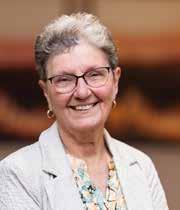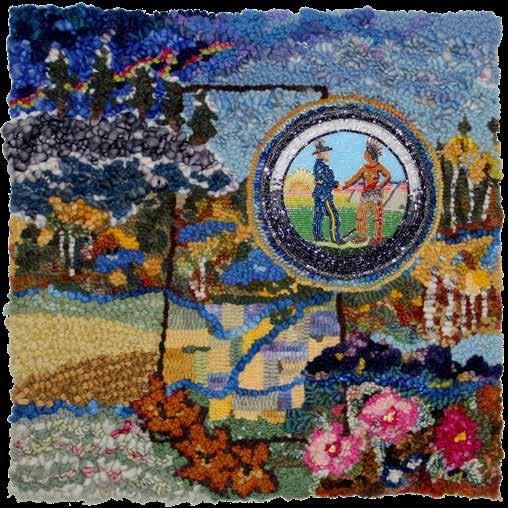

Message from the President
BY SUE AMUNDRUD
AS WINTER IS upon us once more, I hope you are enjoying your preferred ways to remain active and involved – an important aspect of a successful retirement. We continue our daily routine of walking two active dogs – bundled up, of course, to match weather conditions – while staying involved with other organized activities that primarily occur on a September to June schedule.

Each quarter I look forward to reading the articles featured in our current issue of Outreach. The article in our fall issue on Wills and Estates made me think, and the follow-up here reminds us to pay attention to tasks that will make life easier for those we leave behind.
It has become apparent that artificial intelligence is going to be part of our lives, like it or not. I hope you welcome the opportunity to learn more about the benefits it offers in the article reprinted here. The challenges it brings will be in the February issue.
Two of our members played a significant role in ensuring that Saskatchewan was visually represented at the Canada Summer Games held
in Newfoundland in August – please read the article by Shirley Humphries about the rug they created focusing on Truth and Reconciliation which includes her own creative work.
I find, in my travels to meet with chapters, that many members do not truly understand what it means when we say that the STS “is affiliated with” specific organizations. One of the articles in this issue specifically focuses on an explanation of our relationship with the STF, SSM, and ACER-CART.
We hope you find it helpful.
And while I’m on the topic of chapter visits, I continue to welcome invitations to your chapter meetings – one of the features of this role that I enjoy most is the opportunity to meet individually and in somewhat smaller groups with our members and to have the discussions that matter to you. Please contact me to arrange a convenient date and time. ●
ISSN 2817-1721 (Print)
ISSN 2817-173X (Digital)
All articles in Outreach represent the information and opinions of the authors and not necessarily those of the STS.
Reminders
STS Group Benefit Plan holders who are eligible for the Saskatchewan Seniors’ Drug Plan may be eligible for a reduced premium by providing the STS Office with a copy of the Seniors’ Drug Plan confirmation letter. For information on the Saskatchewan Seniors’ Drug Plan, please speak with your pharmacist or contact the Seniors’ Drug Plan office at 1-800-667-7581. If you live in Regina please call 306-787-3317.
For any changes to your address and/or Group Benefits coverage, please contact the STS Office directly at 306-373-3879 or email sts@sts.sk.ca
Do you have a story idea, topic or image you would like us to consider? Email us at sts@sts.sk.ca
Content Curator
Kevin Schmidt
Executive Director Murray Wall www.sts.sk.ca
BELOW IS A selection of photos by members of the STS. Do you have a photograph, idea or a topic you would like us to consider? Email us at sts@sts.sk.ca




Please note that if you'd like your photos to be considered for the cover of Outreach, they must meet the following requirements: a minimum resolution of 3000 x 3000 pixels and a file size greater than 10 MB. For all other photos, we recommend they meet at least 1000 x 1000 pixels and be larger than 1 MB in size.
From Our Readers
Hooked In Saskatchewan
BY SHIRLEY HUMPHRIES

THE TAPESTRY OF PRIDE was unveiled at the Canada Summer Games 2025 in St. John’s, NL. We five artists wanted to represent Saskatchewan and support the creative vision of Atlantic colleagues in this inclusive and unifying project.
We collaborated in reconciliation to interpret the history of land sharing in our province using the traditional artisan crafts of rug hooking and beading. These art forms are our cultural traditions and our personal passions. We weathered some gentle breezes, grew together and at the same time felt that we were part of something bigger than ourselves.
Saskatchewan
(‘Kisiskatchewanisipi’, “swift flowing river” in Cree)
We are all Treaty people.
The Royal Proclamation 1763 recognized First Nations lands and governments and set out a treaty process. Treaties are land sharing agreements between autonomous Indigenous nations and the British Crown which delegated its power to the Canadian federal government in 1867. Treaty implementation considers the context and their nature beyond the written text. Six treaties signed between 1871 and 1906 cover the land that became Saskatchewan in 1905. (See Office of the Treaty Commissioner www.otc.ca)
The federal government did not provide the amount of land, livestock, equipment, food, money nor services stated in the Treaties. Government forced Indigenous peoples to move to reserves, restricted their movement and commerce, and forcibly removed children from their families, culture and communities. The Government of Canada apologized in 2010 for the residential school system and its intergenerational harm. The government established the Truth and Reconciliation Commission to educate all Canadians about our history and to help forge new relationships.
The land is also the Saskatchewan Métis Nation Homeland. Métis are descendants of Indigenous and Euro-Canadian parents. They were interpreters, guides and settlers. The Métis sought and continue to seek, nation to nation relations with the Government.

We are five artists who created this representation of Saskatchewan. Inspired by Treaty history and our love to create, we have collaborated and acted in reconciliation. Our rug features a beaded image of a Treaty medal surrounded with rounds of yellow, green and blue. These colours represent the spirit and intent that the Treaties last “as long as the sun shines, the grass grows and the rivers flow.”
As in nature, the land extends beyond the map of Saskatchewan and is shown south to north through the seasons from spring flowers and grasslands; flowering summer crops of grains (ex. barley, oats, wheat), oil seeds (canola, flax) and pulses (lentils and peas); and autumn parkland forests to winter’s snow laden spruce on rock under northern lights. Depicted are the provincial emblems, prairie lilies and white birch trees, and slogan, Land of Living Skies. Prairie roses and the Métis infinity symbol are hooked near the Qu’Appelle Valley, an important site for exchange and treaty negotiations.
Today, more people understand the need to reconcile the impact of past actions and to honour our responsibilities to and with Indigenous peoples. We hope that in this art, you will see the power of collaboration and reconciliation as well as the diversity and natural beauty of our province. Saskatchewan motto: From many peoples, strength.
Our rug is respect and learning. It is collaboration and cooperation. It is bigger than the sum of our individual work. We artists gathered once in Regina (Jane joined by Zoom) to meet each other and to finalize our purpose and the design elements. Our goal was to recognize that Saskatchewan, a political entity, became possible because of several land sharing agreements or Treaties. ●
Tapestry of Pride 2025 –Saskatchewan – Five Artists

VANEA CYR
A skilled beader of 40 years, Vanea learned the art of beading attending the Qu'Appelle Indian Residential School in Lebret, SK. A full time educator, Vanea (Cree) uses beading as a meditative and reflective space. She takes pride in seeing her intricate creations worn and is honoured by others’ ownership of her pieces. Among her works are powwow regalia for her husband and daughter, and beadwork for Prince Charles and various Chiefs. Vanea believes beading is a gift; she is dedicated to ensuring this gift is shared, teaching others at her home.

MARGARET HARRISON
Taught by her mother, Margaret is an accomplished Métis fibre artist including floral embroidery and hooked rag rugs. She continues these arts and teaches others in order to honour the creativity, hard work and dedication of Métis women. Her inspiration comes from the Qu’Appelle Valley, her home growing up. Margaret’s art has been featured by the Gabriel Dumont Institute, Parks Canada historic sites, the Remai Modern Art Gallery in Saskatoon, in Calgary and Regina Prairie Interlace: … 1960s-2000s. In 2024, the Saskatchewan Arts Council commissioned Margaret to do a rag rug for its archives.

SHIRLEY HUMPHRIES
With both parents doing handwork for pleasure, Shirley’s hands got busy, too, after her retirement as an educator. Her cousin introduced her to the Prairie Harvest Rug Hooking School (PHRHS) and a rug hooking mentor in Regina, Jan Hague. Fascinated by the colours, textures, tools and camaraderie, Shirley takes classes and experiments. She enjoys meeting others and expanding her rug hooking options. Shirley gifts her hooking to others or uses it at home.

JANE MACLEOD
Raised and educated in Amherst, Nova Scotia, Jane moved to Saskatoon in the 1970s to begin a life-long career as an educator. Jane recalls hooking rugs as a child and as an adult, inspired and supported by Deanne Fitzpatrick and her team in Amherst. Jane renewed her interest in rug hooking in 2009 while living in the United Arab Emirates. Since her return to Canada in 2016, Jane has enjoyed connecting and creating with rug hookers in Saskatchewan and around the world. Her rugs are gifted to friends and family or adorn her home.

SHELLY NICOLLE-PHILLIPS
Born and raised on Prince Edward Island, work brought Shelly to the prairies over twenty years ago. A family and the prairies keep her here! A fibre artist living and creating in Regina, she creates art using traditional rug hooking technique with a variety of natural fibres. Rug hooking is Shelly’s meditative space. Her Prairie Alphabet purchased by the Saskatchewan Arts Council in 2024 features at risk prairie plants. Shelly spreads the love, selling her art and teaching others the simplicity and beauty of rug hooking. Hooked on the Prairies.
Writing an Ethical Will
BY MAGI MCFADDEN
WRITING AN ETHICAL Will, organizing documents for a legal Will, naming powers of attorney, and having hard conversations with loved ones are all part of the process of estate planning. By going through this process, you will learn about yourself, your life, and what you want to leave behind for your loved ones. This will not only be of benefit to you, but for those who depend on you.
FOR YOU WHEN I AM GONE BY STEVE LEDER
While few of us want to think about our deaths or what our last words will be, writing an ethical Will, a document that includes reflections about our past, can include jubilation and regrets. Rabbi Steve Leder has written a poignant guide to help us pass our last wishes, legacies, and final farewells on to our loved ones. Delineating a 12step approach that provides guidance for telling your life story and sharing wisdom with loved ones, Rabbi Leder provides thought-provoking questions including: What do you regret? When was the last time you led with your heart? What makes you happy? What was your biggest failure? What got you through your greatest challenge? What is a good person? What is love? Have you ever cut someone out of your life? How do you want to be remembered? What is good advice? What will your epitaph say? What will your final blessing be? Retrospective examination of your life using these 12 questions will help get you started writing your narrative. An ethical Will becomes both a meaningful way for your loved ones to remember you and a primer on how they can live more fulfilling lives. ●
Magi McFadden is a member of the Regina Chapter of the STS and has served at the chapter level as social committee co-chair. Magi is also a member of the STF professional growth network LEARN and has served at the provincial level and local council level of LEARN as president, vice president, and editor of their official publication “Query” for more than a decade.
Rabbi Steve Leder has written a poignant guide to help us pass our last wishes, legacies, and final farewells on to our loved ones.

To borrow this book, please email the Emma Stewart Resources Centre at esrc@stf.sk.ca or call 1-800-667-7762.

The following is part 2 of a 2-part series.
A Cautionary Tale: Life Lessons on Wills and Estates Part 2
BY JEROME LINNELL
IF YOU ARE named as the Executor of someone’s estate, you may decline the role, as long as you have not started managing any part of the estate, which is known as “intermeddling”. When my friend passed, his sister renounced her executorship by filling out a legal document and sending it to my lawyer. I filled out an application to administer the estate and sent it to the probate court in my friend's province of residence along with his Will and financial information. It is a time-consuming process to gather all this documentation, even with the help of a lawyer. While this is happening, no one is legally responsible for the estate.
If you think about what is happening, you will realize that this is not a good situation. Bills must be paid – the mortgage, the heat, the power. Banks and credit card companies need to be notified. Taxes must be paid. Someone needs to make decisions on a funeral and my friend’s remains (burial or cremation).
Yes, my friend’s sister could help over the phone, but she could not handle every detail of the funeral (and shouldn’t have to).
Legally, I was not yet responsible for the estate until the court approved my submission, but there would have been massive problems with the estate if I had not acted.
My idea was to do whatever I could. Fortunately, most contacts were very sympathetic with the situation. I was able to cancel his credit cards and freeze his bank accounts. I was able to file his income tax with CRA and apply for the death benefit to put toward the funeral. This was possible because my friend had made a detailed list of all his personal information – driver’s licence number, SIN, credit card numbers, subscriptions, etc.
LIFE LESSON #4: NOT EVERY COMPANY WILL BE AS HELPFUL AS YOU HOPE IN ESTATE MATTERS.
The bank declined to pay any bills or his mortgage. It is true (as my lawyer pointed out) that the bank should be willing to protect the assets of the estate by paying the power and heating bills. I did learn that what a bank should do and what they are willing to do are two different things. Before you think too critically about banks, you must remember that they have a responsibility to their organization that surpasses their responsibility to you. That is, it may have been helpful to me for the bank to agree to do everything I wanted. However, what if the estate doesn’t have enough money to pay for everything, and they are following instructions of someone who is not the administrator (yet) of the estate? The local bank could get into legal trouble with the beneficiaries.
... what a bank should do and what they are willing to do are two different things.
LIFE LESSON #5: HAVING A LOCAL BANK WITH PEOPLE THAT KNOW YOU IS THE MOST IMPORTANT THING YOU CAN HAVE FINANCIALLY.
I realized that I would need short term money to look after the expenses of the estate. The estate had enough cash resources to pay me back once the Will passed through probate court, but before that happened, I became a lender to the estate. The problem with this is that the expenses outpaced my estimates, and our family savings were wiped out. Now I was in some short term personal financial trouble. Fortunately, my local credit union was beyond helpful, and after listening to my situation, they approved a line of credit that solved the problem.
It took ten months in total, from the time of my friend’s passing to the approval of the Will, and my grant of administration by the probate court. Now that I had access to the estate funds, I could pay bills from the estate account, pay off my line of credit and other expenses, and begin to carry
out specific financial instructions from the Will. Things happened very quickly at this point, as I now had the documentation (I was the legal estate administrator) to carry out matters of the estate without barriers.
LIFE LESSON #6: LEARN EVERYTHING THAT YOU CAN ABOUT WILLS AND ESTATES.
Even if you are never an Executor for someone else’s estate, you should be considerate about what will happen to the people who are affected by your Will. You might think that you are being generous by passing a house, land, or other property to a beneficiary. However, that might trigger large capital gains or a tax bill that will put them in a financial bind. An estate planner can be a valuable resource. There is a lot of information on the internet that can help you prepare as well.
In my case, I had to pass funds from the estate to a school in the United States. This is not as straightforward as you might think. In addition, I had to get the estate finances approved by the beneficiaries. Fortunately, I found helpful information and forms to assist with both situations. A lawyer could have assisted me with both these tasks, but I felt confident that I had the knowledge to finish the last part of the estate myself.
It is easy to look back now and see how things could have been different. My friend and I both made mistakes in not preparing ourselves for the situation. It is hard to talk about what happens after someone dies, but good conversations will save much trouble and headache down the line. Estates can be complicated, but we can navigate them with some planning and forethought. Perhaps it is time that you, as the reader, have that conversation with someone you know. Good luck and good planning!
Jerome Linnell is a retired teacher living in Melfort, Saskatchewan. He has taught high school science, computer science, and mathematics for 35 years in Estevan and Melfort. He has five adult children and resides with his wife of 29 years, Kelly, who is an active teacher at Melfort Comprehensive. He is an active member of the Carrot River Valley Chapter of the STS.

Planning for the Future: Power of Attorney
BY PUBLIC LEGAL EDUCATION ASSOCIATION OF SASKATCHEWAN (PLEA)
WE OFTEN TAKE our ability to make our own decisions for granted. We may not want to think about what would happen if we could no longer make our own decisions, but planning for it gives us back a measure of control. Appointing someone as your Power of Attorney (POA) is one way to plan for a time when you may not be able to act for yourself.
KEEPING CONTROL
Giving someone Power of Attorney allows you to decide who can act for you and when they can act for you. You can appoint a POA to manage some, or all, of your financial affairs. You can also authorize your POA to make personal decisions for you about your life, however, the POA cannot make health care decisions. For this, you need to create a Health Care Directive.
You must appoint someone to act for you while you are still able to make your own decisions. You might want to do this so someone can help
you with things such as paying bills and making deposits to your bank account. If you are no longer able to make your own decisions this type of POA ends.
You can prepare for a time when you cannot make your own decisions by appointing an Enduring Power of Attorney. The Enduring POA continues, even if you lose capacity, so your Enduring POA can manage both your financial and personal affairs.
If you lose capacity to make your own decisions and do not have an Enduring POA, someone
would need to apply to the court to become your adult guardian.
If you are still able to make your own decisions, you can continue to act for yourself and change or end both of these types of POA at any time.
CHOOSING YOUR POWER OF ATTORNEY
Your POA must be at least 18 years of age. They must be able to understand any information needed to make decisions on your behalf and understand the consequences of making or not making a decision for you.
There are certain people who cannot be appointed under an Enduring POA. This includes a person who is an undischarged bankrupt if they will be dealing with your finances. People who have been convicted of certain crimes such as assault, fraud, or breach of trust, as well as any whose job involves providing health or personal care services to you, cannot be appointed as your Enduring POA.
Other than these restrictions, you can name anyone you choose as your Enduring POA. It can be a relative, friend, lawyer, or an officer of a bank or trust company. The person you choose can refuse to take on the responsibility, so it is important to discuss the matter with them first.
FORMALITIES
Members of your family and family members of the POA you are appointing cannot be witnesses. Witnesses must complete the witness certificate in the form required by the legislation.
Except for the witness certificates, you do not need to use any form for a Power of Attorney, but there are templates you can use. These, and the form for the witness certificates, can be found on saskatchewan.ca
PROTECTIONS AND PRECAUTIONS
The law provides some protection for people who give someone POA. The law requires a POA to act honestly, in good faith, in your best interests and with the care that could reasonably be expected of a person with the POA’s experience and expertise. There are also accounting requirements which will show things such as your assets, debts and acts that your POA has to perform.

Even with these protections, it is still important to appoint someone you trust. There is always some risk involved when you give someone else the power to manage your affairs. The authority you give someone to act for you can be abused. The Government of Canada’s publication, What Every Older Canadian Should Know About: Powers of Attorney and Joint Bank Accounts, provides information that can help you consider and manage the risks. ●
There are rules that must be followed if you want to give someone the responsibility of Power of Attorney. You must be at least 18 and understand the role of POA.
A Non-Enduring Power of Attorney just needs to be in writing and dated and signed by you, however, an Enduring Power of Attorney has more formalities. It must clearly state that you want the person to be able to act for you if you can no longer make your own decisions. It must also be witnessed. This can be done by a lawyer who has given you legal advice on the document. Two adults can be witnesses instead of a lawyer.
This article was prepared and written by the Public Legal Education Association of Saskatchewan (PLEA). PLEA is a non-profit, non-government organization providing free legal information across a variety of platforms. They offer programs and services to the general public and school communities across Saskatchewan through dedicated websites, print resources, presentations and more.
To learn more about this area of the law, check out the Planning for the Future section of PLEA’s website at plea.org. The legal information that PLEA provides is intended as general information only and should not form the basis of legal advice of any kind. Individuals seeking specific legal advice should consult a lawyer.

Understanding Artificial Intelligence
BY BILL BROOKS
There has been considerable hype about this thing called Artificial Intelligence. There has been lots of praise and consternation for all the things it can do or might do in the future. It seems to have appeared just recently and will be the saviour of the future or the downfall of [humankind]. Let’s take a closer look at this phenomenon.
Artificial Intelligence (AI) – what exactly is it? In straightforward terms, AI refers to computer systems (hardware and software) that can perform tasks that traditionally required human intelligence. These tasks include learning, reasoning, problem-solving, understanding language, art, literature and poetry and recognizing patterns. The human brain can process an amazing amount of information and make sense of it. Up until now computer systems have not been powerful enough to do that. This is changing.
Virtual assistants can set reminders, control household appliances, warn of potential hazards and even automatically adapt to changes in personal preferences.
AI research started in the 1950s and 1960s and performed very specific tasks that were supervised by humans. It evolved as the capabilities of computers, computing power and data storage increased. Connecting with the internet provided access to large amounts of data that AI systems needed for learning.
AI systems can rapidly collect and categorize information. Sophisticated tools like virtual assistants, recommendation systems on Amazon, and even self-driving cars become possible.
Some of the things that we can do with ease – facial recognition, speech recognition, drawing, creating music – traditionally have been very difficult for machine intelligence, but not anymore.
A lot has been said about AI, both positive and negative. In this article I will highlight a few positive examples. Part 2 (in the next issue of Outreach) will look at some of the other aspects of AI.
There are many ways AI can make life generally better for older adults. For example:
• Healthcare: AI is being used for diagnoses, personalizing treatment plans, and assisting in surgeries. Automated caregivers have been developed, some targeting remote locations. Preliminary evaluations show patients are generally enthusiastic about the assistants. Recently AI has been used to diagnose certain cancers with a 99% accuracy rate. Diagnosis rates by humans are usually in the 80% range.
• Education: AI educational tools can provide personalized learning experiences, helping students of all ages learn at their own pace. These tools also assist teachers by grading assignments, tracking student progress and recommending different approaches for different styles of learning.
• Convenience: AI simplifies daily tasks such as managing schedules, shopping online, and using smart home devices. Virtual assistants can set reminders, control household appliances, warn of potential hazards and even automatically adapt to changes in personal preferences.
• Safety: AI technologies in self-driving cars and traffic management systems reduce accidents and improve road safety. It is also used in security systems to detect and prevent potential threats.
These are just a few examples of how AI can improve the lifestyles of older adults.
In Part 2, I will look at some of the drawbacks and the future of AI. ●
‘Understanding Artificial Intelligence: Part 1’ found in the Spring 2025 issue of Saskatoon Council on Aging’s Coming of Age Newsletter is reprinted with permission.
Dr. Brooks has a science background working in fields requiring innovation and creativity such as aerospace and science education. He is an active volunteer with Leadership Saskatoon and the Saskatoon Council on Aging, where he is a board member, presenter, writer and radio host. He received the Saskatchewan Volunteer Medal for 2024 from the provincial government for his long-standing commitment to volunteerism.
STS Has Many Important Partnerships
BY OWEN SEBASTIAN, MURRAY WALL, AND HELEN SUKOVIEFF
SASKATCHEWAN TEACHERS’ FEDERATION
by Owen Sebastian
In October 1973, 32 superannuates met to establish the Superannuated Teachers of Saskatchewan (STS). They had concerns over the inequality of teachers’ pensions and the desire to improve the lives of pensioners.
Bi-level bargaining began in 1973, and the Saskatchewan Teachers’ Federation (STF) started negotiating many items at the provincial level, including pensions. The STS understood that it
would need to work with the STF if it wanted to improve pensions. Over the last fifty years, there have been significant changes to teacher pensions, including improvements proposed by the STS. The STS has also provided support to the STF during provincial bargaining.
The STS and STF maintain close relations in other areas. In 1979, the STS became an STF local association with representation on STF Council and at local association leadership events. Since 1991, the STS has supported the McDowell Foundation through an annual donation along
with representation on the foundation’s board, and research on some projects funded by the foundation.
At the local level, there are many examples of cooperation between STS chapters and STF local associations. After a life spent in schools, many STS members maintain an interest in issues affecting education. Whether it is providing support during collective bargaining or working together on retirement celebrations or social events, STS and STF members work together to improve the lives of their members.
STS and STF members work together to improve the lives of their members.
SASKATCHEWAN SENIORS MECHANISM
by Murray Wall
The Superannuated Teachers of Saskatchewan was one of 10 founding members of the Saskatchewan Seniors Mechanism (SSM) in 1990. The Vision Statement of SSM is Quality life for all older adults in Saskatchewan and their Mission is to bring together Saskatchewan seniors’ organizations for the purpose of contributing to a better quality of life for seniors. Since SSM is an organization with interests consistent with the Aims of the STS, we are pleased to be affiliated with them, to partner with them and to support their activities.
SSM hosts various speakers and conferences, supports Age-Friendly Saskatchewan, promotes Social Prescribing and Ageism Awareness, supports continuing research and advocacy, and has launched a Home Supports initiative. Considerable information and resources, including videos of past conferences are available on their website (www.skseniorsmechanism.ca). SSM was also involved in the 2024 Saskatchewan General Election and was a support in the development of our own STS election materials. In 2025-2026, the STS Executive has three members who serve as representatives or liaisons
with SSM, namely, Huguette Kitchen, Sunil Pandila and Owen Sebastian. Also, STS Executive member Joyce Hoffman and two additional STS members are currently serving on the SSM Board of Directors.
CANADIAN ASSOCIATION OF RETIRED TEACHERS
by Helen Sukovieff
The Superannuated Teachers of Saskatchewan (STS) is a member organization of the Canadian Association of Retired Teachers (ACER-CART).
ACER-CART is a national voice for retired teachers and focuses on advocating for the interests of retired teachers across Canada. This includes lobbying the federal government for fairness on such items as taxation and seniors' benefits. The STS, in turn, participates in ACER-CART's advocacy efforts and has a representative on their Board of Directors.
As an example, both the STS and ACER-CART have been working together on issues related to the Canadian Dental Care Plan. Ensuring that retired teachers are aware of eligibility requirements is an important part of this. In the case of retired Saskatchewan teachers, because we have access to a dental plan through the STS, we are not currently eligible for the Canadian Dental Care Plan. However, we have not given up, and we continue to work towards being part of the national program in the future.
Bill C-64: An Act Respecting Pharmacare was passed last October and brought us closer than we’ve ever been to achieving single-payer drug coverage in Canada. What is still needed is for the federal government to commit to continuing to negotiate Pharmacare deals with provincial governments, including Saskatchewan. Bilateral agreements have been signed with Manitoba, British Columbia, Prince Edward Island and Yukon. It is crucial that our federal and provincial governments work collaboratively to ensure the Pharmacare program is implemented and expanded as quickly as possible. The millions of Canadians in need of life-changing medications shouldn’t have to wait a day longer.
As you can see, our affiliation with ACER-CART is an important way we can support the interests of STS members. ●
Events




